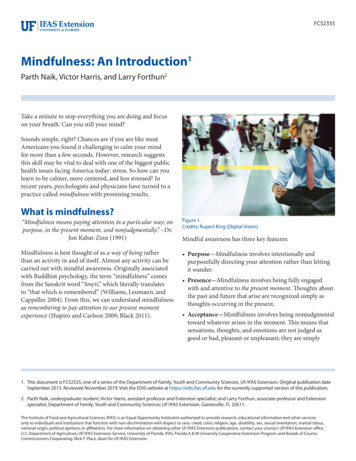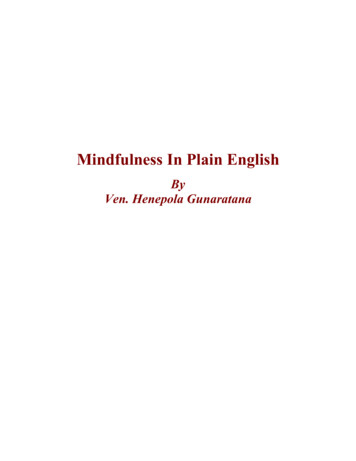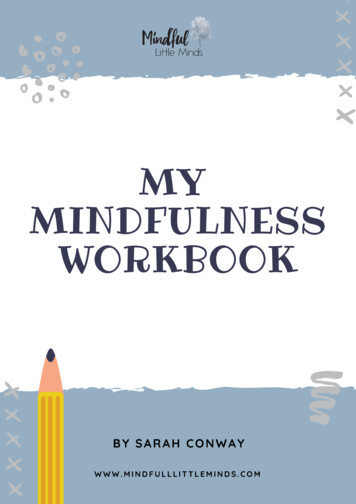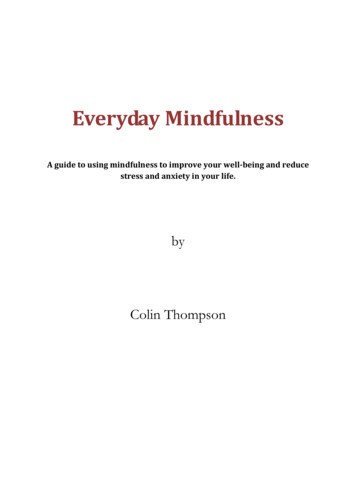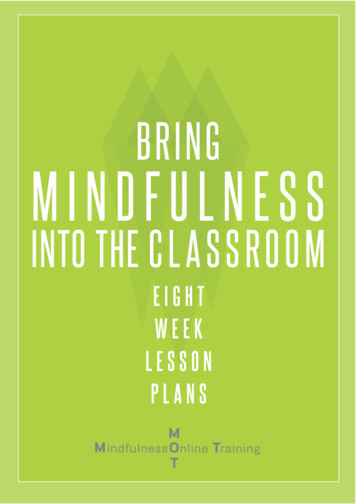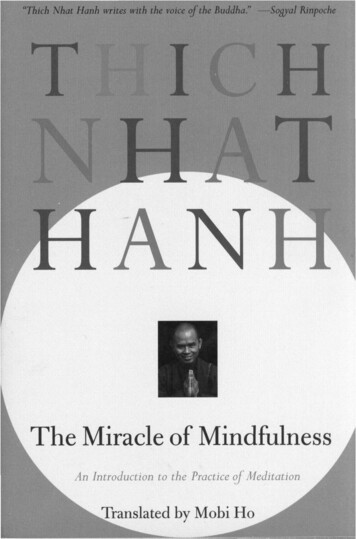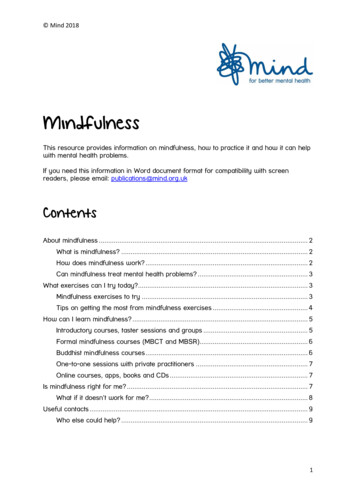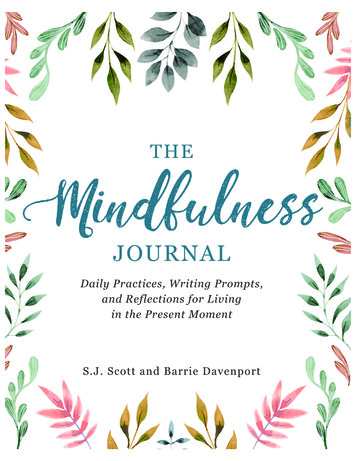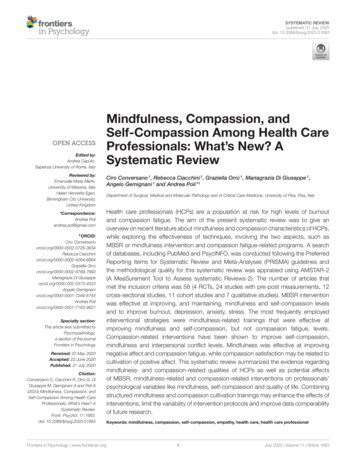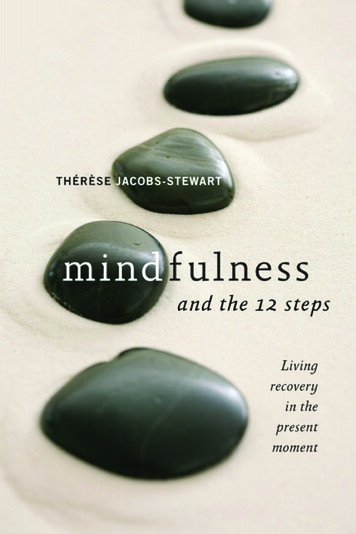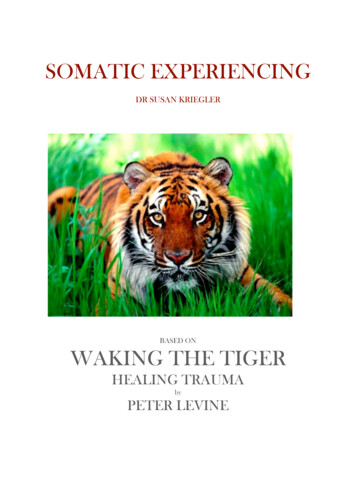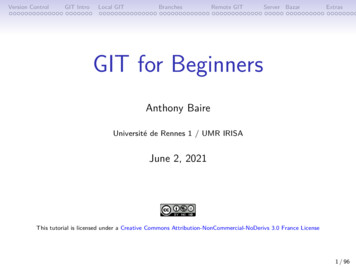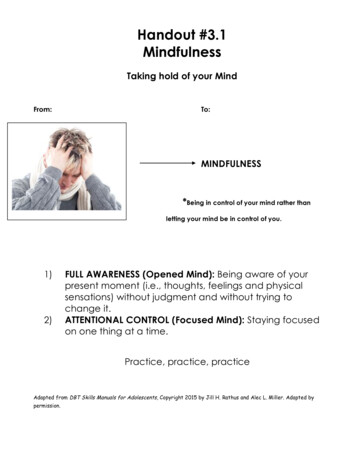
Transcription
Handout #3.1MindfulnessTaking hold of your MindFrom:To:MINDFULNESS*Being in control of your mind rather thanletting your mind be in control of you.1)2)FULL AWARENESS (Opened Mind): Being aware of yourpresent moment (i.e., thoughts, feelings and physicalsensations) without judgment and without trying tochange it.ATTENTIONAL CONTROL (Focused Mind): Staying focusedon one thing at a time.Practice, practice, practiceAdapted from DBT Skills Manuals for Adolescents, Copyright 2015 by Jill H. Rathus and Alec L. Miller. Adapted bypermission.
Handout 3.2MINDFULNESS: Why Bother?Being Mindful can:1. Give you more choices and more control over your behavior2. Reduce your emotional suffering and increase your pleasure3. Help you make important decisions4. Help focus your attention and make you more effective andproductive5. Increase compassion for self and others6. Lessen your pain, tension and stress and in turn can evenimprove your healthPractice, Practice, PracticeAdapted from DBT Skills Manuals for Adolescents, Copyright 2015 by Jill H. Rathus and Alec L. Miller. Adapted bypermission.
Handout 3.3MINDFULNESS3 States of MindReasonableWiseMindMind(What I THINKto be)(What IKNOWto be)EmotionalMind(What IFEEL to be)Emotional Mind is “hot”; ruled by your feelings and urges.Emotional Mind is:When I am in Emotional Mind, I (please describe what you do or think):Reasonable Mind is “cool”; ruled by facts, reason, and logicReasonable Mind is:When I am in Reasonable Mind, I .(please describe what you do or think):Wise Mind includes both reason an emotion; wisdom within each person;state of mind to access when you want to make an important decision.Wise Mind is:When I am in Wise Mind, I Adapted from DBT Skills Manuals Adolescents, Copyright 2015 by Jill H. Rathus and Alec L. Miller. Adapted bypermission.
HANDOUT 3.4PRACTICING WISE MINDMindfulness skills often require a lot of PRACTICE. Like any new skill, it is important to first practicewhen you don’t need the skill. If you practice in easier situations, the skill will become automaticand you will have it when you need it. Practice with your eyes closed and with your eyes open.1. q Stone flake on the lake. Imagine that you are by a clear blue lake on a beautiful sunnyday. Then imagine that you are a small flake of stone, flat and light. Imagine that youhave been tossed out onto the lake and are now gently, slowly, floating through thecalm, clear blue water to the lake’s smooth, sandy bottom. Notice what you see, what you feel as you float down, perhaps in slow circles, floatingtowards the bottom. As you reach the bottom of the lake, settle your attention therewithin yourself.2. q Walking down the spiral stairs. Imagine that within you is a spiral staircase, winding downto your very center. Starting at the top walk very slowly down the staircase, goingdeeper and deeper within yourself. Notice the sensations. Rest by sitting on a step or turn on lights on the way down if youwish. Do not force yourself further than you want to go. Notice the quiet. As you reachthe center of yourself, settle your attention there – perhaps in your gut or yourabdomen.3. q Breathing WISE in, MIND out. Breathing in, say to yourself “WISE”, breathing out, say“MIND”. Focus your entire attention on the word “wise,” then focus it again entirely on the word“mind.” Continue until you sense that you have settled into wise mind.4. q Asking is this WISE MIND? Breathing in, ask yourself, “Is this (action, thought, plan etc.)wise mind?” Breathing out listen for the answer. Listen but do not give yourself the answer. Do not tell yourself the answer; listen for it. Continue asking during each inhale. If no answer comes, try again another time.5. q Expanding awareness. Breathing in, focus your awareness on your center. Breathing out, stay aware of your center but expand awareness to the space you arein now. Continue on in the moment.6. q Dropping into the pauses between inhaling and exhaling. Breathing in, notice the pause after inhaling (top of breath). Breathing out, notice the pause after exhaling (bottom of breath). At each pause, let yourself “fall into” the center space within the pause.7. q Other Wise Mind Practice Ideas:Adapted from DBT Skills Training Handouts and Worksheets, Second Edition, Copyright 2015 by Marsha M.Linehan. Adapted by permission.
Homework #3.53 States of MindDue Date:Observing yourself in each of the 3 States of MindReasonableWiseEmotionMindMindMindEmotional MindOne example of Emotional Mind this week was (please describe your emotion/s, thoughts,behaviors):Reasonable MindOne example of Reasonable Mind this week was (please describe your emotion/s, thoughts,behaviors):Wise MindOne example of Wise Mind this week was (please describe your emotion/s, thoughts,behaviors):Adapted from DBT Skills Manuals for Adolescents, Copyright 2015 by Jill H. Rathus and Alec L. Miller. Adapted bypermission.
Mindfulness skills often require a lot of PRACTICE. Like any new skill, it is important to first practice when you don’t need the skill. If you practice in easier situations, the skill will become automatic and you will have it when you need it. Practice with your eyes closed and with your eyes open. 1.!Stone flake on the lake. Imagine that you are by a clear blue lake on a beautiful sunny .
